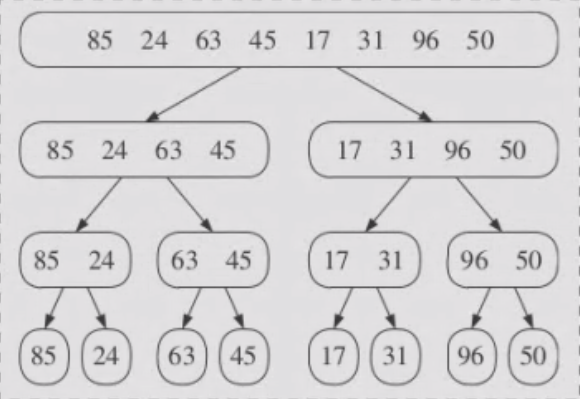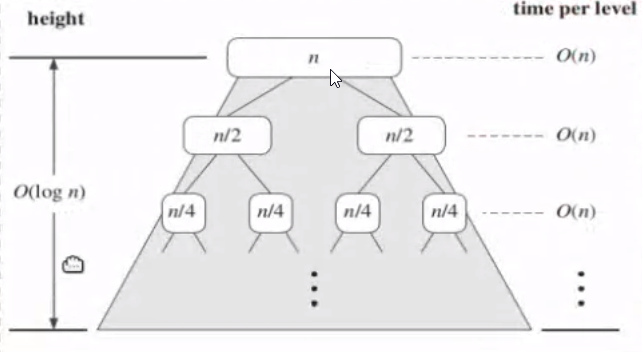Week 6#
Lecturer: Pritam Bhattacharya, BITS Pilani, Goa Campus
Date: 4/Sep/2021
Topics Covered#
- Merge Sort
- Steps
- Algorithm
- Merge Function
- Sort Function
- Algorithm Analysis
- Space Complexity
- Time Complexity
Merge Sort#
Merge Sort is not an in-place sort like the other three that was explained above
Steps#
Let us consider the following arrays
\(4, 1, 7, 5, 2, 3\)
Now let us split this array into two halves:
\(4, 1, 7\ |\ 5, 2, 3\)
And let us sort these two parts:
\(1, 4, 7\ |\ 2, 3, 5\)
When merging the above two parts, we maintain two pointers that start on either parts, and we compare the elements pointed by these two and place the smaller element into a new array and advance that pointer and repeat the above procedure till all the elements are compared.
Algorithm#
Merge Function#
merge(S1, S2, S):
Input: Two arrays, S1, S2, of size n1 and n2 sorted in non decreasing order, and an empty array S of size n1 + n2
Ouput: S, containing the elements from S1 and S2 in sorted order
i <- 0
j <- 0
while i < n1 and j < n2 do
if S1[i] <= S2[j] then
S[i + j] <- S1[i]
i <- i + 1
else
S[i + j] <- S2[j]
j <- j + 1
while i <= n1 do
S[i + j] <- S1[i]
i <- i + 1
while i <= n2 do
S[i + j] <- S2[j]
j <- j + 1
Sort Function#
The actual sorting is done in a divide and conquer fashion denoted by the below steps:
1. Divide: If \(S\) has zero or one element, return \(S\) immediately, it is already sorted, Otherwise put the elements of \(S\) into two sequences \(S_1\) and \(S_2\), each containing about half of the elements of \(S\)
2. Recur: Recursively sort the sequences \(S_1\) and \(S_2\)
3. Conquer: Put back the elements into S by merging the sorted sequences \(S_1\) and \(S_2\) into a sorted sequence.
sort(S):
Input: An array of size n
Ouput: The sorted version of the array S
if n == 1 then
return S
if n == 2 then
if S[0] > S[1] then
S[0] <-> S[1]
return S
S1 <- {S[0], S[1], S[2], .... , S[n/2]}
S1 <- {S[(n/2)+1], .... , S[n - 2], S[n - 1]}
R1 <- sort(S1)
R2 <- sort(S2)
merge(R1, R2, R) # R is an empty array of size n
return R
Algorithm Analysis#
Space Complexity#
The recursive tree for a random input array would look something like this:

From the above image you can see that the number of memory blocks from the root to the leaf node of the recursive tree is at max \(n\), so:
Space Complexity: \(\mathcal{O}(n)\)
Time Complexity#

At every level, we do a total effort of merging in the order of \(\mathcal{O}(n)\)
The total height of the recursive tree is given by the order of \(\mathcal{O}(log\ n)\)
So Time Complexity: \(\mathcal{O}(n\ log\ n)\)
